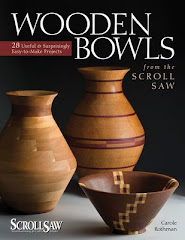I've always drilled blade entry holes when making scrolled bowls. However, sanding out the drill marks can be tedious, so I decided to try an alternative approach--cutting into the ring along the grain instead of drilling. I wanted to see what it looked like, and whether it could serve as an alternative.
I used a pine bowl whose rings had been cut conventionally, except for the smallest ring, which remained to be cut. Instead of drilling, I cut into the ring along the grain at the designated cutting angle of 27˚, continued the cut around the ring, then glued up the cut.
I noticed immediately that although the grain at the top and bottom of the ring matched nicely, the cut on the side was a vertical one and could not be completely hidden, no matter how well it was glued. It reminded me of a scarf joint, which is used to join the ends of two pieces of wood, and means that no matter how neatly you join the ends, or how much you sand, there will always be a scar.
Here are photos of my results. The view of the underside clearly shows what happens when you make the cut, and why the ends can't be completely hidden.
Wednesday, July 5, 2017
Subscribe to:
Post Comments (Atom)







Carole, thank you for showing the results of this cut instead of the entry hole! No short-cuts on the round bowls but I wonder if this cut could be hidden in the end grain of a square bowl?
ReplyDeleteSpeaking of blade entry holes, Lee Valley recently sent out an email promoting their limited quantity hollow-arbor chuck (http://www.leevalley.com/us/Wood/page.aspx?p=75987&cat=1,180,42334&ap=1). They claim to work down to a 0.3mm (#80) drill bit.
I just used this arbor with a #65 bit through 4/4 walnut and got the cleanest hole I have made in a while. Highly recommended and I hope they keep selling it.
Jared, I don't think the shape makes a difference, since all bowls show both end and straight grain. I don't think there's any way to disguise the vertical cut unless you're making a bowl from a slab cut across the trunk so that the end grain runs in an up and down direction. And that would mean all the ring glue-ups were end grain to end grain, and I'm not sure how well that would work.
ReplyDeleteThat Lee Valley chuck sounds interesting, but you still have the issue of drilling at an angle with a very short bit. I find the small chuck for the Dremel works fine for me, along with my primitive, but accurate, angle gauges. The standard chuck of my Delta drill press goes down well below 1/16", but the wire sized bits are so short that they would just about disappear. If I'm careful, start the hole with an awl, and ramp the drilling speed way down, I can get a good hole. Most of the time!
Thanks for writing!